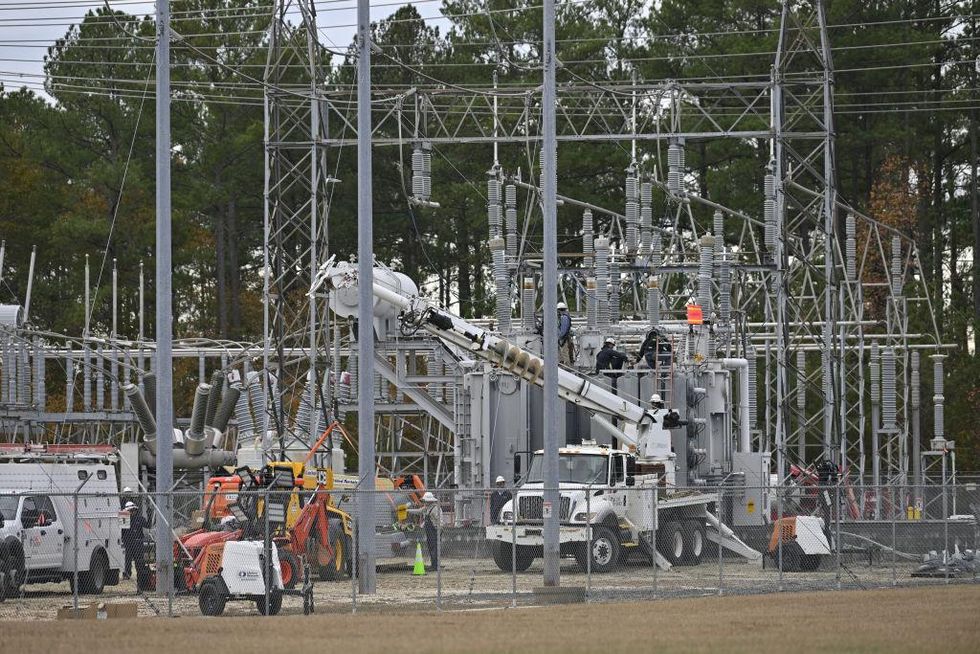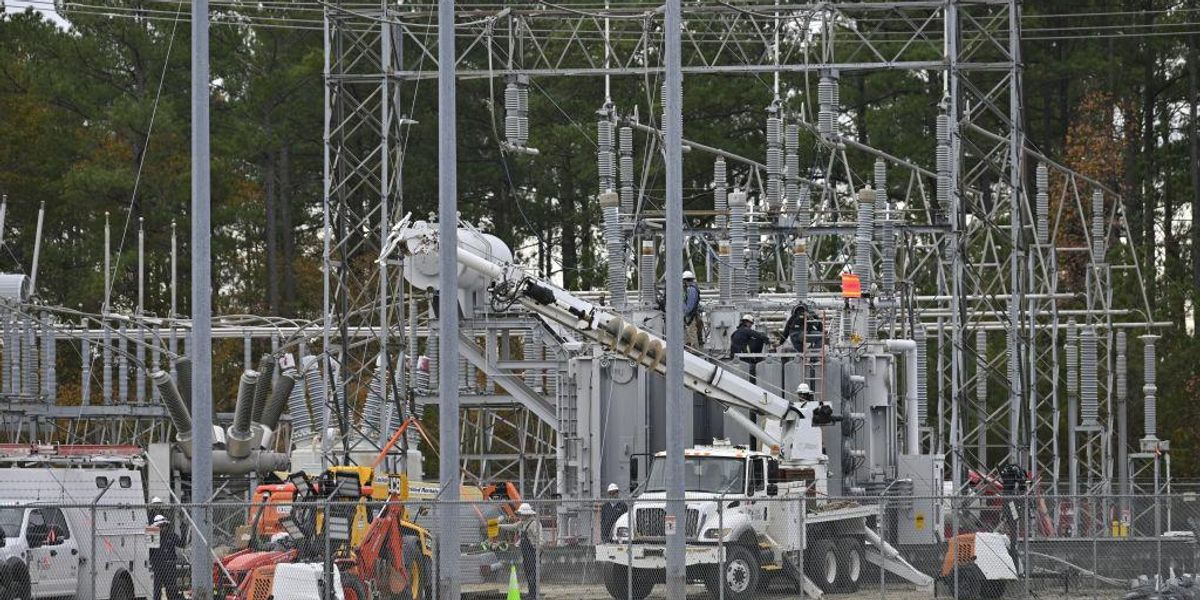
Lost in the rush of political and climate-related news in the closing weeks of 2022 was the small but intriguing story of a December 3rd armed attack on two power substations in Moore County, North Carolina. The installations were severely damaged by gunfire, leaving 45,000 residents to suffer through the winter cold without power, many of them for several days.
A little over two weeks after the attack, a large, swastika-bedecked banner sporting the slogan “BRING IT ALL DOWN” was hung from an overpass on US Route 1, a few minutes’ drive from the substations. The banner included an internet address leading to a photo of an electrical substation under the same “BRING IT ALL DOWN” slogan. That photo had been posted following an earlier substation attack in Maysville, North Carolina, 170 miles away.
In the months leading up to these incidents, far-right elements had shown growing interest in sabotaging the nation’s electrical grid. The US Department of Energy reports “hundreds of physical attacks to electrical systems”—with “the most in the last decade” occurring in 2022. Intentional damage, sabotage, or vandalism accounted for more than one out of four power disruptions across the country during that period. Annual numbers of such attacks have doubled over the past 10 years.
“The rise in attacks on electrical distribution systems has been striking.”
Because the North Carolina strikes caused an especially serious disruption, they broke into the national news cycle. These kinds of stories are typically covered only on the local 11 o’clock news, but this year’s surge in such incidents is coincident with, and potentially connected to, the politicization of energy and climate throughout extremist circles, so it’s a story we should all be keeping an eye on.
Coming off its recent losing streak in the federal courts, in Congress, and finally, at the polls, will the MAGA cult increasingly turn to violent local actions, including sustained assaults on the power grid? If so, what would be the potential consequences for the nation’s electricity supply—something that’s as essential to the maintenance of a high-tech industrial society as food and water, but is also a crucial factor in the global ecological emergency?
Lights out: A very American power struggle
The rise in attacks on electrical distribution systems has been striking. In September, intruders broke into and damaged six substations in Florida, triggering power outages. In early November, someone riddled two substations in Ohio’s Knox and Licking Counties with dozens of rounds from a .308 caliber rifle. The attack resulted in “a power outage giving students a three-day weekend,” according to local reports.
November also saw attacks on at least a half-dozen substations in Oregon and western Washington. According to an FBI memo, the mayhem included “setting the control houses on fire, forced entry and sabotage of intricate electrical control systems, causing short circuits . . . , and ballistic attack with small caliber firearms.” This Pacific Northwest spree resumed on Christmas Day, when vandals broke into and disabled four substations in the Tacoma, Washington, area, plunging 14,000 households into holiday darkness. Two men were arrested on New Year’s Eve and charged with the sabotage.
Then, on January 4, a man allegedly drove a vehicle through the fence surrounding a solar power plant near Las Vegas, parked the vehicle next to a large transformer, and set it on fire. The solar farm—home to 300,000 panels with enough capacity to supply 27,000 U.S. homes—was knocked out of service for at least a week. The man was apprehended and charged with terrorism and arson.
Suspects have not been identified in any of the late 2022 substation attacks other than the Tacoma and Las Vegas incidents. In a November 22 bulletin sent to private industry and obtained by CNN, the FBI warned of a rise in such attacks and stressed that their purpose could well be “to create civil disorder and inspire further violence.” Citing the report, CNN noted that “anti-government groups in the past two years began using online forums to urge followers to attack critical infrastructure, including the power grid. They have posted documents and even instructions outlining vulnerabilities and suggesting the use of high-powered rifles.”
Writing for Newsweek in late October 2022, Tom O’Connor and Naveed Jamali reported on a corporate intelligence security memo describing at least 15 incidents, going back more than a year, in which online extremists urged attacks on electrical substations, cell towers, and pipelines. O’Connor and Jamali examined documents that, they wrote, “could serve to help groups and individuals in carrying out such attacks, including maps, manuals, and instructions on the vulnerabilities of electricity infrastructure and readily accessible methods to disrupt their operation.”
Law enforcement officials are noting that the nation’s 55,000 substations—essentially huge transformers that reduce the voltage of electricity delivered by long-distance lines before it’s distributed to customers—make for juicy targets. Most substations are located in isolated spots that punctuate the nation’s 160,000 miles of high-voltage power lines—places where saboteurs can break into the station or fire a few rounds at the equipment and then make a getaway without being seen. Indeed, it appears that none of this fall’s perpetrators has been identified yet.
Domestic terrorists, officials told the news site Insider, may “feel that disrupting the electrical supply will disrupt the ability of government to operate. . . . And, secondly, by conducting attacks against the communications and electrical infrastructure, [that] it will actually accelerate the coming civil war that they anticipate, because it will disrupt the lives of so many people that they will lose faith in government.”
Writing less than two weeks before Election Day 2022, O’Connor and Jamali argued that these far-right terrorists’ focus on energy infrastructure was no coincidence: “Adding to the volatility of the situation, inflation and rising gas prices have proven top issues among voters, making energy sites an attractive target for groups and individuals seeking to cause mayhem at a politically sensitive time for the nation.”
Pro-white mixes with anti-green
Without knowing who’s responsible for these attacks, we can’t know for certain if the perpetrators’ goals are connected to energy and climate or just general disruption and chaos. My guess is that most of the actions so far have been, like the North Carolina attacks, more pro-white than anti-green. But we have also seen how, in their reactionary fervor, far-right movements can be fluid when it comes to the specific causes they ally themselves with.
Think of the Proud Boys, who are currently on trial for seditious conspiracy in federal court. They came to prominence because of their associations with Trumpism and their central role in the January 6 attack on the Capitol, but they’ve since piggybacked on a broad array of cultural battles over Covid lockdowns, masks and vaccines, critical race theory, trans hate, and QAnon fever dreams.
“In their reactionary fervor, far-right movements can be fluid when it comes to the specific causes they ally themselves with.”
Now, in ginning up their followers over the supposed loss of their “freedoms,” far-right leaders increasingly cite climate and energy issues alongside their usual appeals to white patriarchy. Speaking in September to the ultra-right student-led movement Turning Point USA, radio host and provocateur Alex Jones (who did more to assemble and mobilize the January 6 mob than just about anyone with a last name other than Trump) was asked by TPUSA’s Charlie Kirk how the Green New Deal and “environmental fascism” connect to what the far right has come to call the “Great Reset”: the claim that a global liberal elite is plotting to control humanity. Jones responded, “If energy was a chess piece for the globalist game plan, on the board, it’s the queen.” That, he said, means, “if you control energy, you control populations, you can bring them to their knees.”
Ted MacDonald of Media Matterswrites,
While conspiracy theories related to the Great Reset as a whole are not new, issues of climate denial associated with the Great Reset have been gaining momentum across right-wing media in recent months, fueled by the global energy crisis and a summer of climate-fueledweather disasters. . . . Notorious climate denier Marc Morano was pushing this idea as early as 2020, when he stated on the December 21 edition of Fox News’ Tucker Carlson Tonight that the Biden administration will “go from COVID lockdowns to climate lockdowns.”
MacDonald quotes Carlson himself claiming, “Energy is civilization. . . . People don’t understand how threatening [Democrats’ climate policy] is and how close we are to being under the complete and total control of people who wish us ill.”
Rita Katz, the founder and executive director of the SITE Intelligence Group, told the reporters O’Connor and Jamali, “Immediately after the reports about the [December 3] attacks, we at SITE saw such communities praise what happened in North Carolina and call for more, while sharing more directives about what to target and how to do so. Some have specifically suggested large cities,” where you-know-what kinds of communities live.
Simon Purdue, director of the Domestic Terrorism Threat Monitor, told O’Connor and Jamali, “The situation in Moore County offers only a glimpse into the chaos that attacks such as this can cause, and larger scale assaults could bring disruption on a statewide or even national level.” Purdue has seen “a steady slew of manifestos, social media posts, videos, and even instruction manuals on this kind of attack being produced by extremists over the past few years.”
Will a “green” electric grid be even more vulnerable?
Today’s electric grid is highly complex, aimed at rerouting power to fully align supply with demand at every location in the country, continuously. That mission includes instantaneously and precisely adjusting for every supply interruption, large or small. Coordinated attacks by people with a good understanding of how the grid works could potentially overwhelm the system, triggering cascades of blackouts over broad areas.
CNN intelligence analyst John Miller believes that right-wing extremist groups’ ultimate aim is to take out large swaths of the national power supply: “Their theory is that if you identify the key nodes and you knock out one and they divert power to the next one, and you knock out the next one and the next one, a domino effect can actually start to topple the national grid and plunge the nation into darkness and chaos.”
“To make matters worse, a future, much greener power grid may be even more vulnerable to widespread breakdowns.”
To make matters worse, a future, much greener power grid may be even more vulnerable to widespread breakdowns. Eliminating fossil fuels from the nation’s power supply will require the buildout of a vastly larger energy-delivery system. According to the National Renewable Energy Laboratory, a fully “decarbonized” electric grid would need to have two to three times the capacity of our current grid. It would also have to be even more comprehensively fine-tunable than today’s grid, to make a gazillion adjustments a minute, rerouting power across vast areas, from solar or wind farms that are at that moment enjoying plenty of sun or wind to areas where renewable power stations are not producing enough. And, as Politicoobserves,
the number of critical grid components vulnerable to attack will only grow as the U.S. expands the power grid over the coming decades and as more people and businesses buy electric vehicles. Wind and solar power plants in particular are often in remote areas where fewer grid protections may exist—and they offer more entry points for attack than a single power plant.
A less vulnerable power grid can be achieved, experts suggest, through fortification of power installations and armoring of all equipment that’s vulnerable to gunfire. Stepped-up surveillance is needed as well. But protecting 50,000 (or, in our more electrified future, perhaps 150,000) substations would be astronomically costly, and it still wouldn’t eliminate wider threats to the electrical system, much less our quests for ecological renewal and pluralistic democracy. Those carrying out such attacks, whoever they are, might simply move on to other targets in our technologically complex, increasingly fragile economy.
Having suffered serious setbacks in the political arena throughout last year, the MAGA cult may be embracing even more warmly the idea that political violence can be a more effective means of achieving the sinister goal that they are failing to reach through legal and political means: an authoritarian takeover of US society. Disinformation and violence failed to get them what they wanted on January 6, 2021, and they must not be allowed to prevail in 2023.
The original version of this article was published by City Lights Books as part of its ‘In Real Time’ series.




